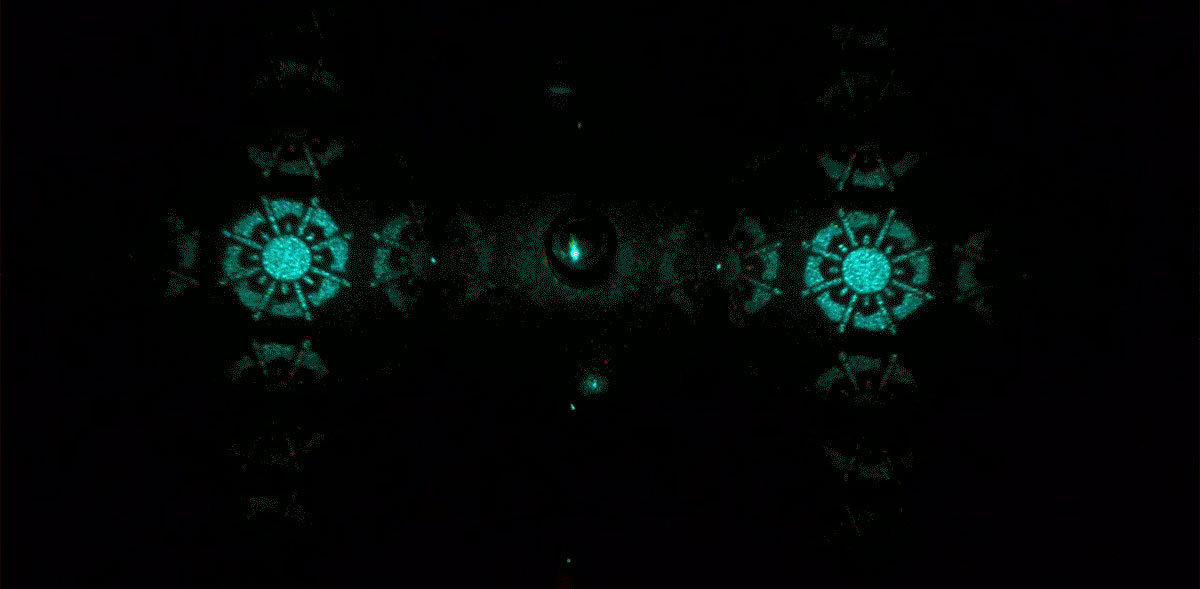How 'Nano-fins' Make Better Holograms

Holograms projected on a white screen while changing the wavelength of light from blue to red.
Capasso Lab
Use with credit to Capasso Lab
(Inside Science) -- By relying on scientific advances that recently helped develop invisibility cloaks, scientists have created a new kind of hologram that they suggest could be used in virtual reality and augmented reality headsets, and prevent counterfeiting of cash and credit cards.
Conventional holograms are a special kind of 2-D photograph that, when illuminated, seem like windows onto 3-D scenes. The properties of each pixel in a hologram -- such as pixel size, dimensions, orientation and transparency -- lead them to scatter the light falling on them in very specific ways, causing light waves to interact with each other to generate images with the illusion of depth.
One drawback of holograms is that they are often only visible if a viewer is positioned directly in front of them. Now, by applying recent scientific breakthroughs to a technique developed at the beginning of computer-generated holography, researchers have developed holograms that are visible from a wide range of angles.
Fifty years ago, scientists created the first computer-generated holograms. The advantage of computer-generated holography is that the objects it portrays do not have to physically exist, much as computer-generated imagery now often depicts things found solely in the imagination.
Early computer-generated holograms relied on arrays of apertures that caused light waves passing through them to interfere with each other to form holograms. However, these arrays each only worked with specific wavelengths of light.
Now, researchers have updated this old approach to holography with metamaterials, which are structures that can control waves of all kinds using components that are smaller than the waves in question. Recent advances in metamaterials have enabled startling breakthroughs, such as cloaks that can hide objects from light, sound, heat and other types of waves.
In the new study published Friday in the journal Science Advances, the scientists developed a "metasurface" consisting of transparent glass surfaces covered with arrays of nano-fins -- microscopic bars of silicon each 85 nanometers wide, 350 nanometers long and 1,000 nanometers high, located about 500 nanometers from each other. (In comparison, the average human hair is about 100,000 nanometers wide.)
The resulting "metaholograms" "could be seen in a wide range of wavelengths, from visible to near-infrared," said study co-author Antonio Ambrosio, a physicist at Harvard University in Cambridge, Massachusetts. In experiments, they depicted images such as letters and shapes including the flower-like logo of the International Year of Light.
Moreover, the metahologram-generated images can be seen from angles as wide as 50 degrees. This means they can produce images "that are visible even if they are close to the eye," Ambrosio said, which opens up their possible use in virtual reality headsets such as the Oculus Rift and augmented reality headsets such as the Microsoft HoloLens. Current virtual and augmented reality goggles usually supply a pair of small 2-D images to create the illusion of 3-D -- a holographic display may do a better job at creating 3-D views.
Previous research had created holograms using metasurfaces, but the ones most efficient at generating images worked by reflecting light. In contrast, the new metaholograms are transmissive, which means they generate images by letting light through them. This means they could be used in displays to project images at viewers.
Furthermore, these new metaholograms can project different images depending on the direction in which light waves vibrate, a property known as polarization. This could make them useful in preventing counterfeiting, such as with cash or credit cards, said study lead author Mohammadreza Khorasaninejad, a physicist at Harvard. For instance, such metaholograms could display a sequence of certain images only when illuminated with light with a specific polarization.
Cheng-Wei Qiu, an optical physicist at the National University of Singapore who did not take part in the research, noted that advanced fabrication techniques such as deep ultraviolet lithography and nanoimprinting could help mass produce the proposed devices.
"That's extremely important to drive real impact from scientific ventures," Qiu said.
The researchers are now working with new materials and fabrication methods to increase the efficiency of their holograms with visible light. Harvard's Office of Technology Development has filed patents on this research and related technologies and is actively pursuing commercial opportunities.

